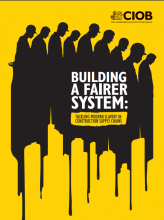Building a fairer system: Tackling modern day slavery
On 13 July 2016, the Chartered Institute of Building (CIOB) published Building a fairer system: Tackling modern slavery in construction supply chains. It was produced in consultation with businesses and NGOs such as Amnesty International, Engineers Against Poverty and the Institute for Human Rights and Business.
In 2015, the UK Modern Slavery Act came into force, requiring UK organisations with a turnover of more than £36 million to report how they deal with human rights issues in their supply chains. The CIOB report is part of an effort to drive forward their campaign in response to the legislation.
'Building a fairer system' calls for greater industry collaboration to eradicate unfair labour practices. It makes clear that slavery remains a hidden problem in many sectors, with the International Labour Organisation estimating that there are 21 million people in forced labour around the world. The construction industry faces particular challenges in tackling these abuses because of its fragmented supply chain, a lack of transparency in the procurement process, and the high demand for migrant labour.
The report makes a series of recommendations for the construction supply chain:
Recommendations for tier one organisations:
- Map out supply chains and identify areas of highest risk, geographically and by activity. Tackle these areas first.
- Lead policy from the top of an organisation, at CEO and COO level.
- Provide tailored training and education to staff at all levels of the business.
- Work directly with labour supply agents and/or increase the proportion of directly employed labour on a project.
- Take more responsibility for shifting the culture in lower tiers of the supply chain: provide support and training for SMEs.
- Collaborate with NGOs that can provide support and understanding of the complex challenges of different regions.
- Set a long term strategy by following international guidance produced by organisations such as the UN Global Compact, the Ethical Trading Initiative, the Institute for Human Rights and Business, OECD or the International Labour Organization.
Recommendations for procurement teams and materials producers:
- Educate procurement teams and improve communication between the professions - designers, engineers and architects and project managers - to ensure that boardroom policy is translated to site and subcontractor levels.
- Embed robust checking procedures that do not default to box ticking exercises or ineffective audits.
- Work directly with suppliers to help them improve their practices.
Recommendations for industry:
- Participate in cross industry initiatives, sharing best practice and drawing on expertise from other sectors.
- Encourage and support the development of ethical recruitment companies.
- Influence and lobby clients and governments to accelerate change.
- Encourage widespread adoption of ethical standards.
The report also examines a number organisations working to shift cultural practices and norms. These include Qatar Rail's worker welfare strategy, and Hewlett Packard's move to direct labour.
In addition to the report, CIOB launched an industry toolkit, as well as a series of training packages in collaboration with specialist providers.
--CIOB
[edit] Related articles on Designing Buildings Wiki
- Building Site to Boardroom (BS2B).
- CIC Economic and Policy Briefing 2017.
- CIOB and Stronger Together.
- Construction and the Modern Slavery Act.
- Diversity in the construction industry.
- Ethical labour sourcing standard.
- Ethical sourcing.
- Ethics in construction.
- International Ethics Standards Coalition.
- Investors In People award CIOB silver accreditation.
- Modern slavery.
- Modern slavery in the construction sector.
- Modern Slavery Act and sustainable supply chains.
- Modern slavery and the supply chain.
- Modern slavery toolkit.







